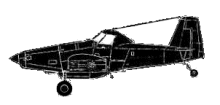
ASN Wikibase Occurrence # 200608
This information is added by users of ASN. Neither ASN nor the Flight Safety Foundation are responsible for the completeness or correctness of this information.
If you feel this information is incomplete or incorrect, you can submit corrected information.
| Date: | Monday 31 July 2017 |
| Time: | 11:40 |
| Type: |  Air Tractor AT-802A |
| Owner/operator: | Private |
| Registration: | N70LA |
| MSN: | 802A-0102 |
| Year of manufacture: | 2000 |
| Total airframe hrs: | 3653 hours |
| Engine model: | Pratt & Whitney PT6A-67AG |
| Fatalities: | Fatalities: 0 / Occupants: 1 |
| Aircraft damage: | Substantial |
| Category: | Accident |
| Location: | Wells, NV -
 United States of America United States of America
|
| Phase: | Landing |
| Nature: | Fire fighting |
| Departure airport: | Battle Mountain, NV (BAM) |
| Wells, NV (LWL) | |
| Investigating agency: | NTSB |
| Confidence Rating: |
The commercial pilot reported that at the conclusion of the flight, he entered the left downwind leg of the airport traffic pattern, and observed about 10 knot winds from the north. He subsequently configured the airplane for a wheel landing to runway 26. The tailwheel had been in the "locked" position from the time he departed on the accident flight. Shortly after the main landing gear touched down, the airplane began to veer to the right. As the tailwheel came down, the airplane suddenly departed the right side of the runway in a hard right turn. The left main landing gear impacted an imperfection in the runway, the airplane then rotated spinning 180 degrees to the right before it came to rest.
The pilot, experienced in the accident airplane make and model, reported no mechanical anomalies with the control system before the accident. Postaccident examination of the control system revealed no abnormalities with the rudder and aileron. The pilot further stated that he departed with the tailwheel in the "locked" position, and only disengaged the locking mechanism during the landing roll to regain control of the airplane. The manufacturer reported that landing with the tailwheel in the "unlocked" position will typically result in a tailwheel shimmy, and may not have led to a further loss of directional control. A weather study indicated an absence of fronts and weather systems and a presence of variable winds consistent with local circulations and thermals at the time of the accident. Additionally, the airport manager reported that thermal activity is prevalent at her airport, and that multiple runway excursions occur each year due to variable wind conditions and other phenomena. With the presence of variable winds in the morning and subsequent thermal activity at the time of the accident, it is likely that a sudden wind shift or thermal activity overwhelmed the pilot, which resulted in a loss of directional control and the airplane's subsequent excursion from the runway.
Probable Cause: The pilot's failure to maintain directional control during a period of thermal activity, which led to a runway excursion and impact with terrain.
Accident investigation:
 |
|
Sources:
NTSB
Location
Revision history:
| Date/time | Contributor | Updates |
|---|---|---|
| 26-Oct-2017 19:51 | ASN Update Bot | Added |
Corrections or additions? ... Edit this accident description
The Aviation Safety Network is an exclusive service provided by:


 ©2024 Flight Safety Foundation
©2024 Flight Safety Foundation